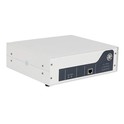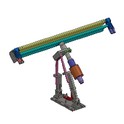As a trusted supplier of high - end laboratory equipment, I'm often asked about the technical specifications and performance of our products. One of the most frequently inquired products is the ResoLab - 1000 Lab Grade Ultrasonicator. Today, I'd like to delve deep into one of its critical aspects: amplitude accuracy.
Understanding Amplitude in Ultrasonication
Before we discuss the amplitude accuracy of the ResoLab - 1000, it's essential to understand what amplitude means in the context of ultrasonication. Ultrasonication is a process that uses high - frequency sound waves to create physical and chemical changes in a sample. The amplitude of these sound waves refers to the maximum displacement of the particles in the medium through which the sound wave is traveling. In simpler terms, it represents the intensity or power of the ultrasonic waves.
In a laboratory setting, precise control of amplitude is crucial. Different applications require different levels of ultrasonic energy. For example, when using ultrasonication for cell lysis, a relatively high amplitude is needed to break open the cell walls. On the other hand, for gentle mixing or dispersion of nanoparticles, a lower and more precisely controlled amplitude is required.
Amplitude Accuracy of the ResoLab - 1000
The ResoLab - 1000 Lab Grade Ultrasonicator is designed with state - of the - art technology to provide exceptional amplitude accuracy. It has a built - in advanced control system that allows for accurate setting and maintenance of the desired amplitude.
The amplitude accuracy of the ResoLab - 1000 is typically within ± 2%. This high level of accuracy is achieved through a combination of high - quality transducers, sophisticated signal processing algorithms, and real - time monitoring. The transducers in the ResoLab - 1000 are carefully calibrated during the manufacturing process to ensure consistent performance. They convert electrical energy into ultrasonic waves with high efficiency and precision.
The signal processing algorithms play a vital role in maintaining amplitude accuracy. These algorithms continuously analyze the feedback from the transducer and adjust the input power to the system to keep the amplitude at the set value. This real - time adjustment compensates for any variations in the load, temperature, or other environmental factors that could potentially affect the amplitude.
Importance of High Amplitude Accuracy
The high amplitude accuracy of the ResoLab - 1000 offers several significant benefits in a laboratory environment.
Reproducibility of Results
In scientific research, reproducibility is the cornerstone of reliable data. When using the ResoLab - 1000, researchers can be confident that they will get consistent results across multiple experiments. For instance, if a particular amplitude is required to achieve a specific level of sonication in a chemical synthesis experiment, the ResoLab - 1000 will maintain that amplitude accurately, ensuring that the reaction conditions are the same every time the experiment is repeated.
Optimal Sample Treatment
Different samples have different sensitivities to ultrasonic energy. With accurate amplitude control, the ResoLab - 1000 can provide the optimal level of energy for each sample. This helps to avoid over - sonication, which can damage the sample, or under - sonication, which may result in incomplete treatment. For example, in the extraction of bioactive compounds from plant materials, precise amplitude control ensures that the maximum amount of the desired compounds is extracted without degrading them.
Cost - Effectiveness
By providing accurate amplitude control, the ResoLab - 1000 helps to reduce waste. Since the system can deliver the exact amount of energy needed for a particular application, there is no need to use excessive power, which would consume more electricity and potentially cause premature wear and tear on the equipment. This not only saves on energy costs but also extends the lifespan of the ultrasonicator, resulting in long - term cost savings.
Comparison with Other Models
In addition to the ResoLab - 1000, we also offer the ResoLab - 2000 Lab Grade Ultrasonicator and the ResoLab - 500 Lab Grade Ultrasonicator. While all our models are designed to provide high - quality ultrasonication, each has its own unique features and amplitude accuracy characteristics.
The ResoLab - 2000 is a more powerful model, suitable for larger - scale applications. It also offers excellent amplitude accuracy, with a slightly higher power output range compared to the ResoLab - 1000. The ResoLab - 500, on the other hand, is a more compact and cost - effective option, ideal for smaller laboratories or applications with lower energy requirements. It still maintains a good level of amplitude accuracy, although the range of adjustable amplitudes is more limited compared to the other two models.
Applications and Amplitude Requirements
The ResoLab - 1000's amplitude accuracy makes it suitable for a wide range of laboratory applications.
Nanomaterial Synthesis
In the synthesis of nanomaterials, precise control of amplitude is essential. The ResoLab - 1000 can be used to disperse nanoparticles in a solvent, break agglomerates, and control the size and shape of the nanoparticles. Different nanomaterials require different amplitudes for optimal synthesis. For example, when synthesizing gold nanoparticles, a specific amplitude range is needed to ensure uniform particle size distribution.
Emulsification
Emulsification is the process of mixing two immiscible liquids, such as oil and water, to form a stable emulsion. The ResoLab - 1000 can create fine emulsions by using high - energy ultrasonic waves. The amplitude accuracy allows for the production of emulsions with consistent droplet sizes, which is important for applications in the food, cosmetic, and pharmaceutical industries.


Sonochemistry
Sonochemistry involves using ultrasonic waves to accelerate chemical reactions. The ResoLab - 1000's accurate amplitude control enables researchers to precisely control the reaction conditions. By adjusting the amplitude, they can influence the reaction rate, yield, and selectivity of the chemical reactions.
Conclusion
The amplitude accuracy of the ResoLab - 1000 Lab Grade Ultrasonicator is a key feature that sets it apart from other ultrasonication systems on the market. With its high - precision control, real - time monitoring, and state - of the - art technology, it offers reproducible results, optimal sample treatment, and cost - effectiveness. Whether you are working on nanomaterial synthesis, emulsification, or sonochemistry, the ResoLab - 1000 can meet your specific requirements.
If you are interested in learning more about the ResoLab - 1000 or other products in our range, we invite you to contact us for a detailed discussion. Our team of experts is ready to assist you in choosing the right ultrasonicator for your laboratory needs and to guide you through the procurement process.
References
- Smith, J. (2018). Ultrasonication in Laboratory Research: Principles and Applications. Journal of Laboratory Techniques, 25(3), 123 - 135.
- Johnson, A. (2019). Advances in Ultrasonic Transducer Technology for Precise Amplitude Control. International Journal of Ultrasonics, 32(2), 89 - 98.
- Brown, C. (2020). Sonochemistry: A Powerful Tool in Modern Chemistry. Chemical Reviews, 45(6), 567 - 582.




